Clemency isn't the only way for governors and legislators to show mercy. Our report provides a roadmap with several options.
November 15, 2018
More than 200,000 people in state prisons today have been there for a decade or more. But even when governors and legislators want to give these individuals a “second chance,” they’ve had no handbook for doing so – until now.
In a new report, the Prison Policy Initiative presents eight ways for states to help people serving excessive prison sentences finally go home. “Clemency is far from the only option,” said author Jorge Renaud. “We don’t have to invent new strategies – there are many out there that are vastly underused.”
His report Eight Keys to Mercy gathers examples of innovations from around the country, and presents these strategies as a slate of options, including:
- Ways to fix broken state parole systems, such as presumptive parole;
- Solutions for states where few people are eligible for parole, such as second-look sentencing;
- Common-sense reforms, such as expanding good time, to support people already working hard to get out (and stay out) of prison.
The report’s eight recommendations also include:
- Visual aids and explainers, including a detailed guide to present-day parole systems;
- Instructions for implementing reforms while avoiding common pitfalls;
- Fact sheets for all 50 states, meant to help policymakers and journalists quickly assess the problem where they live.
Mercy doesn’t begin and end with the governor. But in most states, the systems designed to help people leave prison – such as parole, good time and compassionate release – are skewed towards keeping them inside. “This can’t continue to be the norm,” said Renaud. “People should not spend decades in prison without meaningful opportunities for their release.”
Read the full report and recommendations here: https://www.prisonpolicy.org/reports/longsentences.html
The report includes a new, data-rich visualization of women in jails, highlighting a critical area for criminal justice reform.
November 13, 2018
Women in the U.S. experience a starkly different criminal justice system than men do, but data on their experiences is difficult to find and put into context. In a new report produced in collaboration with the ACLU’s Campaign for Smart Justice, the Prison Policy Initiative fills this gap in the data with a rich visual snapshot of how many women are locked up in the U.S., where, and why.
In Women’s Mass Incarceration: The Whole Pie 2018 (a detailed update to the inaugural 2017 version), Legal Director Aleks Kajstura pieces together data from the country’s fragmented systems of confinement, producing a detailed “big picture” visualization as well as a separate close-up view of women in local jails.
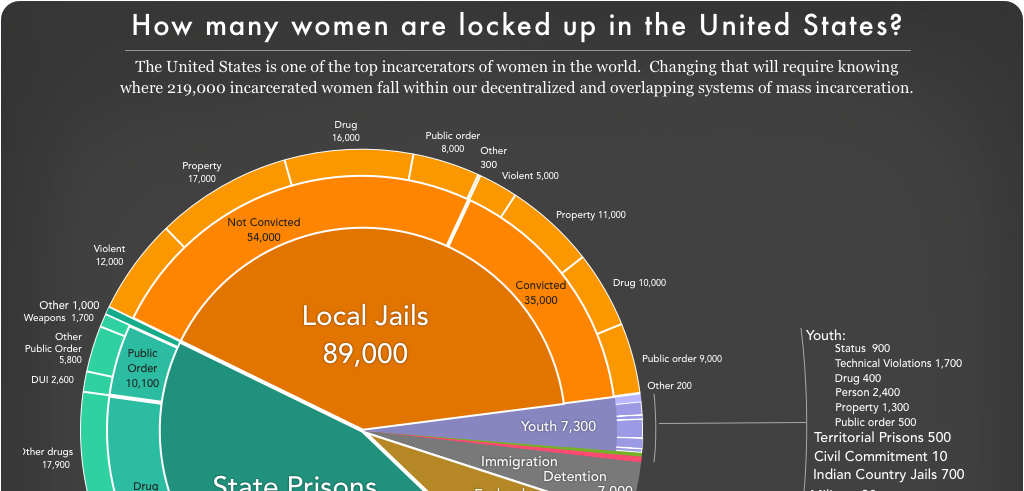
Kajstura’s analysis reveals that:
- 56% of women in prisons or jails are there for drug or property offenses, compared with approximately 40% of the general incarcerated population (which is almost entirely male).
- 7,000 immigrant women are in confinement every day awaiting deportation or an immigration hearing.
- 54,000 women are behind bars every day without a conviction, typically because they cannot afford money bail.
- While 219,000 women are behind bars every day, over 1 million are on probation, suggesting that probation reform is also a women’s issue.
“With this big-picture view, it’s easier to see why many state-level reforms unintentionally leave women behind,” Kajstura said. Her analysis particularly underscores the need for local reforms to county jails:
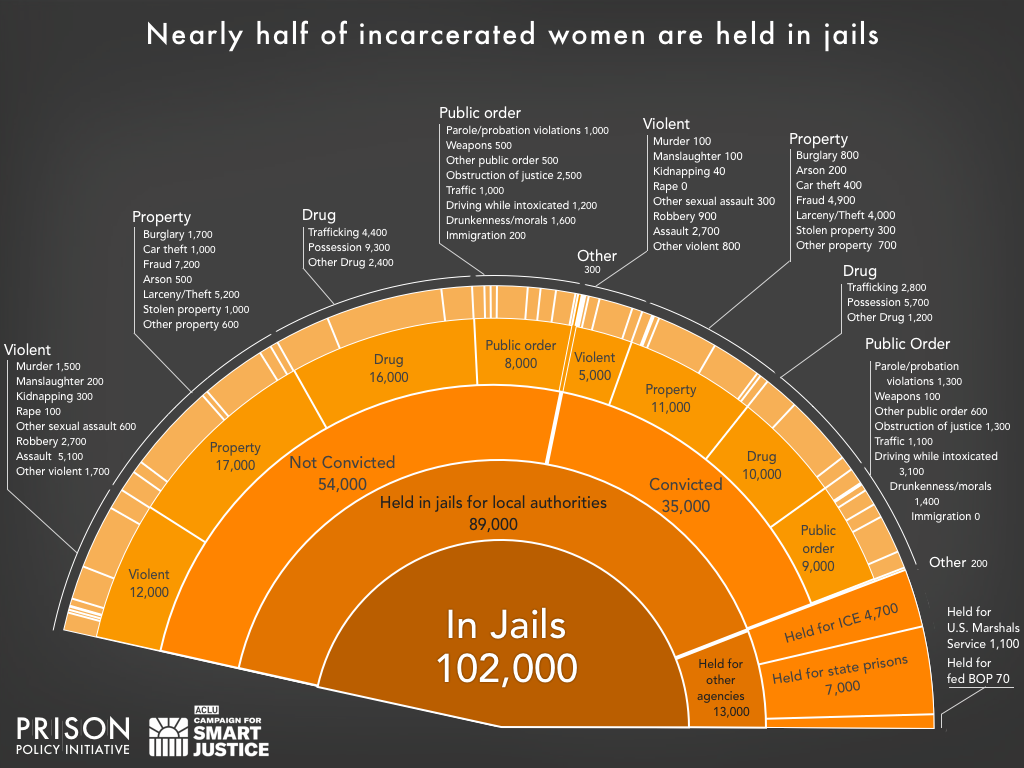
- Incarcerated women are far more likely than men to be held in local jails, both before trial and while serving their sentences.
- Of all immigrant women held for ICE, 4,700 are not in detention centers, but “rented” beds in local jails.
- 80% of women in jail are mothers, and most are the primary caretakers of their children.
- Mental health care is notoriously bad in jails, where suicide rates are literally off the charts.
While states vary widely in how many women they put behind bars, every single U.S. state outranks most independent countries on women’s incarceration, as we found in June 2018 – making reform a moral necessity in every state. Kajstura calls her analysis “the foundation for reforming the policies that lead to incarcerating women in the first place.”
See the full data visualization and report: https://www.prisonpolicy.org/reports/pie2018women.html
Despite recent positive reforms, New York's elderly prison population continues to grow.
by Maddy Troilo,
November 1, 2018
Several years ago, we reported on the elderly prison boom in New York; I thought it was time to update our analysis to examine the impact of recent reforms to the state’s Parole Board.
First, for context, a brief summary of New York’s parole reforms: After sustained effort by advocacy groups, the New York State Board of Parole revised the guidelines that shape their practices–long documented to be harmful to incarcerated people and their families–in September 2016. In June of that year, a campaign to change the composition of the Parole Board was successful, and Governor Cuomo appointed new Parole Commissioners with more diverse backgrounds and no history of abusing the position.
Advocates hoped these changes would increase the rate at which aging and elderly people in New York prisons are granted parole, and alleviate some of the “graying” of the state’s prisons. That happened, to a degree: this year, Release Aging People in Prison (RAPP) found that the Parole Board’s release rates have increased for people 50 or older from 24% to 40%. That change marks meaningful progress, but was it enough to reverse the growth in New York’s aging and elderly prison population?
Unfortunately, no. I found that even as the incarceration rate for all other age groups declines, the number of people age 50 and over incarcerated in New York continues to rise rapidly:
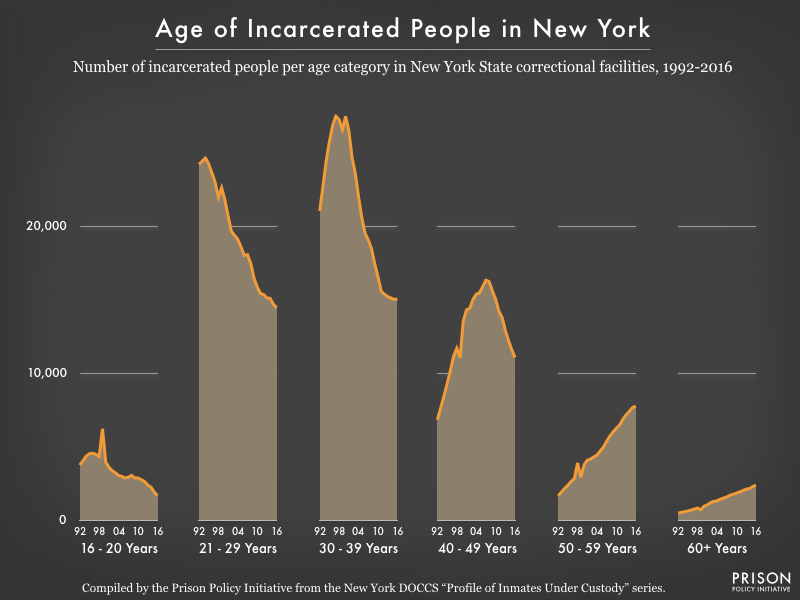 Since 1992, the number of people age 50 and older incarcerated in New York state prisons has steadily increased, while the populations of every other age group have declined dramatically.
Since 1992, the number of people age 50 and older incarcerated in New York state prisons has steadily increased, while the populations of every other age group have declined dramatically.
As we showed in 2015, this rapid increase must be the result of decisions about release, because the number of aging and elderly people admitted to New York prisons only increased slightly. That’s certainly still the case, but I can’t update our graph of the commitment data because the New York Department of Corrections and Community Supervision hasn’t published any new data on people’s age at admission since 2014.
New York needs to do better; aging and elderly people shouldn’t be left behind as younger people continue to benefit from the state’s overall decline in incarceration. The state can begin by making these further changes:
- Seat more people on the board to combat understaffing and dismissing those who abuse and misuse their positions
- End the use of the “nature of the crime” as a factor in parole decisions
- Give more weight to people’s accomplishments while incarcerated
- Institute a meaningful presumption of release at first eligibility
- Acknowledge the fact that elderly people pose no substantial risk to public safety.
The new reforms are important progress, but much more needs to be done. For more information on the campaign to improve the New York Parole Board, see RAPP’s report New York State Parole Board: Failures in Staffing and Performance.
In some counties - like Multnomah County, Oregon - auditors are joining the movement to hold jails accountable.
by Wanda Bertram,
October 31, 2018
Jail reform is on the ballot next week in Multnomah County, Oregon, but it isn’t part of a popular initiative or gubernatorial campaign. It’s a key issue at stake in an unlikely, historically “boring” race: the race for County Auditor.
What could a County Auditor possibly do to reform criminal justice policy? Five years ago, the same question might have been asked about district attorneys or sheriffs. But as the public comes to understand the role that prosecutors, sheriffs and other local electeds can play in reversing mass incarceration, those offices are becoming centers of reform in some areas. The Auditor’s office could be next.
If you think of auditors as glorified bookkeepers, both of the candidates in Multnomah County’s runoff election would disagree. Candidate Scott Learn’s website says the Audit Office “needs to focus far less on informational reports…and far more on helping to improve the effectiveness of crucial county services.” He’s interested in auditing probation and parole services, the local juvenile detention center, and mental health services at the county jail.
Learn’s opponent, Jennifer McGuirk, says that “one of the Auditor’s most important responsibilities is deciding which programs to audit.” McGuirk, too, plans to audit the county’s jails. She was inspired to run after reports emerged of racist abuse in the jails, reports that the previous County Auditor declined to look into.
To be sure, Learn and McGuirk are departing from how auditors have traditionally done their jobs. County Auditors are mainly tasked with rooting out local agencies’ mismanagement of funds.
But to be clear: Abusive, inhumane treatment by criminal justice agencies is a misuse of funds. Jails receive public money (and quite a lot of it) for the purpose of “providing effective detention, rehabilitation, and transition services,” as the Multnomah County Sheriff’s website puts it. Human rights violations fall somewhat outside of this mission, so it’s logical that the County Auditor’s office should investigate.
With two reform-minded candidates neck-and-neck in this race, it’s clear that Multnomah County voters agree that justice reform should be a priority. Will your city or county be next?
Our criminal justice system isn’t just sending people from school to prison – it’s locking them out of education altogether.
October 30, 2018
It’s common knowledge that the U.S. criminal justice system funnels youth from schools to prisons – but what happens after that? How many people, for instance, are able to finish high school during or after prison? A new report from the Prison Policy Initiative breaks down the most recent data, revealing that incarcerated people rarely get the chance to make up the education they’ve missed.
The data shows how incarceration, rather than helping people turn their lives around, cements their place at the bottom of the educational ladder:
- 25% of formerly incarcerated people have no high school credential at all – twice as many as in the general public.
- Formerly incarcerated people are most likely to finish high school by way of GED programs, missing the benefits of a traditional four-year education.
- Less than 4% of formerly incarcerated people have a college degree, compared to 29% of the general public.
The unemployment rate for formerly incarcerated people is a staggering 27%, the Prison Policy Initiative previously found. This rate differs by education level. For those returning home from prison without educational credentials, it is “nearly impossible” to find a job:
- Formerly incarcerated people without a high school diploma or GED face unemployment rates 2 to 5 times higher than their peers in the general public. These rates differ by race and gender, ranging from 25% for white men to 60% for Black women.
- The number of “low-skill” jobs requiring only a high school credential has dropped since 1970, leaving many formerly incarcerated people with even fewer job prospects than ever before.
- Even as college degrees become critical to finding a job, most incarcerated people cannot access degree-granting programs, Pell Grants and federal student loans.
“We need a new and evidence-based policy framework that addresses K-12 schooling, prison education programs, and reentry systems,” report author Lucius Couloute concludes. He offers four far-reaching recommendations aimed at increasing access to educational opportunities, for both incarcerated people and youth at risk.
Today’s report is the third and final part of a new series from the Prison Policy Initiative, focusing on the struggles of formerly incarcerated people to access employment, housing, and education. Utilizing data from a little-known and little-used government survey, Couloute and other analysts describe these problems with unprecedented clarity. In these reports, the Prison Policy Initiative recommends reforms to ensure that formerly incarcerated people – already punished by a harsh justice system – are no longer punished for life by an unforgiving economy.
It’s become habit to consult prosecutors and victims during the release process. States should break that habit.
by Jorge Renaud,
October 25, 2018
While working on an upcoming report about how to shorten long prison sentences, I was disappointed to see that the same experts urging reform are reflexively endorsing part of the status quo. Criminal justice researchers are urging states to change how they consider release for individuals with lengthy prison sentences. However, these reformers continue to recommend that states solicit the input of prosecutors and survivors when making release decisions.
These recommendations reflect established practice rather than progressive policy. States should leave decisions about an individual’s release to professionals who understand that person’s behavior and needs.
Why should prosecutors have a role in the “mercy” process?
The deference shown to prosecutors reaches every aspect of the criminal justice system. Even the reformers who recommend consulting prosecutors on parole decisions and second-look sentencing, however, fail to explain why their involvement is needed in these post-sentencing processes. It strikes me as counterintiuitive that the official responsible for seeking someone’s lengthy sentence should be consulted about that person’s release, yet those recommendations continue.
For example, in the recently approved revision to the Model Penal Code, The American Law Institute recommends a “second-look” provision that would provide review and possible relief to incarcerated individuals who have spent at least 15 years in prison. However, it also recommends that “notice of the sentence-modification proceedings should be given to victims, if they can be located with reasonable efforts, and to the relevant prosecuting authorities.”
I found it almost impossible to find a policy that would mitigate the time a convicted individual must serve, or a parole decision to be made, where it is not recommended – and in some cases mandated – that the deciding officials give prosecutors a chance to weigh in:
- When asked what “sources of input” were considered in release decision-making, 34 of 38 respondents from state parole decision-making bodies said “district attorneys.”
- In 12 of the 24 states profiled by the Robina Institute, state parole decision-making bodies must notify the prosecuting attorney when an individual is being considered for parole; one state mandates a prosecutor’s input must be solicited when an individual with a life sentence is being considered for parole; and 11 states require that the decision-making bodies provide information to the prosecutors upon their request.
This deference toward prosecutors is uncalled for, especially when the only information prosecutors can provide relates to the crime – not to the more important question of whether the person under review has undergone a transformation while incarcerated. Prosecutors are particularly unfit to determine whether individuals they have not seen in years or decades still pose a threat to public safety. As Prof. R. Michael Cassidy at Boston College Law School puts it in a forthcoming paper, “prosecutorial input at parole hearings is likely to accomplish very little beyond either grandstanding for the media or intimidating the parole board into being risk-averse in close cases.”
Recall that between 95 and 97% of all felony convictions are the result of plea bargains between defendants and prosecutors. In offering and accepting a plea bargain, a prosecutor determines when the defendant may be eligible for release and accepts that possibility in exchange for the certainty of a conviction. Whether individuals thus convicted are actually released at that first eligibility date should not be the prosecutor’s concern, only that of the parole board, commutation official, or judge taking a second look.
Finally, there is a strong argument that prosecutorial overreach is responsible for explosive prison growth, both in the numbers of individuals in prison and the astonishingly long sentences many of them have. Although there has been movement toward a progressive prosecutorial approach, exemplified by D.A. Larry Krasner in Philadelphia, it remains to be seen if that approach extends beyond those charged with drug possession and non-violent property crimes. In any case, states should reconsider their choice to include prosecutors in the “mercy” process, given that the punitiveness of prosecutors has created a prison boom.
Should the release process include the views of survivors?
The voices of survivors have become a welcome part of criminal justice proceedings, as they should be. Survivors have an intimate stake in what happens after individuals are sent to prison. But this valuable perspective should be channeled towards advising prison programming, not release. The decision to release an individual should be informed exclusively by an understanding of that individual’s behavior and needs – information that survivors, like prosecutors, simply do not have.
Many people assume that all survivors of violence fit their image of a bereaved family member angrily demanding that a convicted individual be sentenced to life in prison. While many survivors do ask for lengthy prison terms for their attackers, a more accurate picture is presented by a 2016 national survey of survivors of violence commissioned by the Alliance on Safety and Justice. The survey revealed that:
- 60% of victims preferred shorter prison sentences and more spending on prevention and rehabilitation to longer prison sentences;
- Victims were three times more likely to prefer holding people accountable through options other than prison, such as rehabilitation, mental health and drug treatment, and community supervision;
- Victims were also three times more likely to believe that prison makes people more likely to commit crimes than to rehabilitate them;
- And perhaps most poignantly, seven out of 10 victims of violent crimes preferred that prosecutors focus on solving neighborhood problems and stopping repeat crimes through rehabilitation, even if that meant fewer convictions and prison sentences.
To that end, survivors are uniquely positioned to push state departments of corrections to implement programming that focuses on transformation – on nourishing remorse that is grounded not in shame, but in recognition of harm and responsibility. Survivors’ rights groups should be consulted when policymakers are deciding which programs to offer to incarcerated individuals to prepare them for their eventual release.
However, the decision to release an incarcerated individual, or to mitigate that person’s sentence, should be made by professionals with an understanding of that person’s behavior and needs. It should also include input from those who have been in contact with those individuals throughout their incarceration.
Rather than critique the involvement of survivors outright, reformers have proposed meaningless compromises that effectively insult survivors. Reformers suggest, paradoxically, that survivors be allowed to speak at parole hearings but not to recommend approval or denial of parole. That ignores the emotional weight any testimony of a survivor of violence will have on decision makers.
Restorative justice may find a place in our criminal justice system, allowing survivors of violence to heal in ways besides demanding long prison terms for those who have wounded them. Prosecutors may realize that a truly progressive approach means not seeking unimaginably long sentences rooted in retribution. Until then, neither prosecutors nor survivors should have a meaningful voice deciding whether or not to deny freedom to an individual who has served a lengthy sentence.
So why does Trump continue to endorse stop-and-frisk?
by Alexi Jones,
October 12, 2018
President Trump is again encouraging Chicago police to use stop-and-frisk – a policy that allows police officers to stop citizens for virtually any reason – even as new government data reminds us why such policies can be disastrous for people of color. Just days after Trump endorsed stop-and-frisk in Chicago, the Bureau of Justice Statistics released its new report on interactions between police and the public, using survey data from 2015. The report reminds us that police stops and use of force are already racially discriminatory, with predictable consequences for public trust of the police.
The report reveals:
- Black residents were more likely to be stopped by police than white or Hispanic residents, both in traffic stops and street stops.
- Black and Hispanic residents were also more likely to have multiple contacts with police than white residents, especially in the contexts of traffic and street stops. More than 1 in 6 Black residents who were pulled over in a traffic stop or stopped on the street had similar interactions with police multiple times over the course of the year.
- When police initiated an interaction, they were twice as likely to threaten or use force against Black and Hispanic residents than white residents.
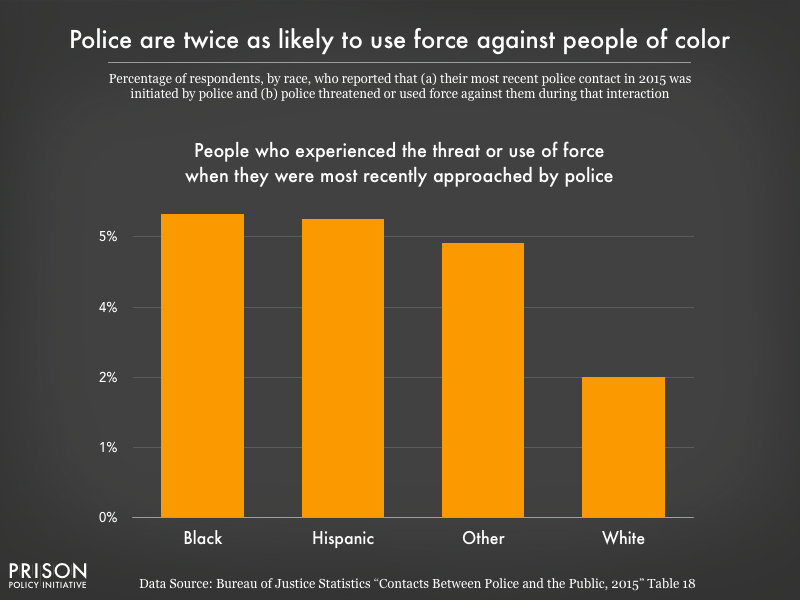
These racial disparities in policing have predictable effects on public trust of the police:
- There were marked racial differences in perceptions of police behavior and legitimacy of police stops. Less than half of Black and Hispanic residents stopped on the street by police thought the stop was legitimate, while two-thirds of white residents did. And 60% of Black residents who experienced the threat or use of force perceived the force as excessive, compared to 43% of white residents who experienced force.
- White residents were more likely than Black, Hispanic, and residents of other races to initiate contact with police – for example to report a crime, a non-crime emergency, or to seek help for another reason. 46% of white residents who had contact with police initiated the contact, compared to less 37% of Black residents.
The report’s findings related to the use of force are particularly relevant to the national conversation about policing. The scale of police use of force alone is overwhelming. Nearly 1 million U.S. residents age 16 or older experienced the threat or use of force by police in 2015. And the people experiencing threats or use of force by police were disproportionately Black and Hispanic.
Previous local studies suggest that stop-and-frisk is particularly discriminatory. In 2010, near the peak of the city’s use of stop-and-frisk, Black residents in New York City were 8 times more likely to be stopped by the police than white residents and 11 times more likely to be frisked. And in 2011, New York City police reported using force in 23% of stops of Black and Latino residents, but in only 16% of stops of white residents.
Given these past and current policing disparities, it is not surprising that Black and Hispanic communities are less trusting of police. As the BJS report shows, Black and Hispanic people are less likely view the use of force as legitimate and less likely to seek help from police compared to white people. This is in line with Pew’s 2016 finding that only about a third of Black Americans believe that police treat racial and ethnic groups equally and that police in their community used the appropriate amount of force, compared to three-quarters of white Americans.
These disparities undermine the legitimacy of law enforcement and create a two-tiered policing system; moreover, they compromise public safety. If residents do not trust the police, they are less likely to report crimes and cooperate with police investigations. So despite what Trump says, stop-and-frisk remains as bad a policy as ever. Police should be looking to address these disparities, not implementing a policy that exacerbates them.
The Pennsylvania DOC introduces a telecom company to a large, captive market for e-books.
by Wanda Bertram,
September 21, 2018
Pennsylvania prisons just ended book donations to incarcerated people, claiming they’ve found a new, better way to provide access to books. Their bright idea? Partnering with telecom giant GTL to sell e-books on tablet computers.
Prison tablets, as we’ve shown, deliver low-quality services at frequently exorbitant prices. Email on a prison tablet requires a paid “stamp.” If that’s an acceptable substitute for email, we wondered, what does GTL think passes for a library?
I intended to find out, but the Philadelphia Inquirer beat me to it, with an article this morning revealing just how insufficient GTL’s book list is. Many of the most popular books among incarcerated people – including dictionaries – are missing. Read the excellent full article here, or my summary on Twitter:
Prison tablets are touted as bringing the outside world to incarcerated people, but all they seem to be doing is bringing a new, captive market to telecom giants. Pennsylvania should allow groups that donate books – groups that walk these companies’ talk – to keep doing their valuable work.
Welcome Alexi Jones, our new Policy Analyst!
by Wendy Sawyer,
September 4, 2018
 Please welcome our new Policy Analyst, Alexi Jones.
Please welcome our new Policy Analyst, Alexi Jones.
Alexi is a 2017 graduate of Wesleyan University and comes to the Prison Policy Initiative with experience in public health research and advocacy. Her shift to criminal justice reform work stems from her experiences in prison education: Alexi has worked as a tutor in prisons in Connecticut and Massachusetts for the past three years, through Wesleyan’s Center for Prison Education and the Petey Greene Program.
Welcome, Alexi!
Two more states have opted to help safe drivers get their lives back on track after drug convictions.
by Aleks Kajstura,
August 29, 2018
Two more states have stopped suspending driver’s licenses for drug offenses unrelated to driving, one of the most counterproductive policies to emerge from the War on Drugs. In January, this law was still on the books in 12 states and D.C. But with D.C.’s reversal in February and Utah and Iowa following suit, the number is now just 10, suggesting that this remains one of the most winnable justice reforms of the moment.
This marks great progress since the release of our report Reinstating Common Sense, which tracks the growing number of states rejecting this outdated and ineffective federal policy. We found that suspending the licenses of safe drivers makes the roads more dangerous, wastes law enforcement resources, and inhibits people with previous involvement in the criminal justice system from fulfilling personal, familial, and legal obligations.
These odd laws were a product of the War on Drugs, when states were eager to pile on any sort of penalties for drug offenses. In 1991 Congress started supporting automatically suspending driver’s licenses for drug offenses, and states (and D.C.) jumped on the idea.
The decades since have proven that such tactics are ineffective as deterrents. And not only do these laws not work, but they actually cause harm: Suspending driver’s licenses for non-traffic offenses decreases public safety on the road while increasing recidivism for those affected. So at the very least, taxpayers are spending a lot of money on making themselves less safe.
The remaining 10 states (Alabama, Arkansas, Florida, Michigan, Mississippi, New Jersey, New York, Pennsylvania, Texas, and Virginia) still suspend over 175,000 licenses every year, so there’s ample room for improvement. Which states will take this common-sense step next?



 Since 1992, the number of people age 50 and older incarcerated in New York state prisons has steadily increased, while the populations of every other age group have declined dramatically.
Since 1992, the number of people age 50 and older incarcerated in New York state prisons has steadily increased, while the populations of every other age group have declined dramatically.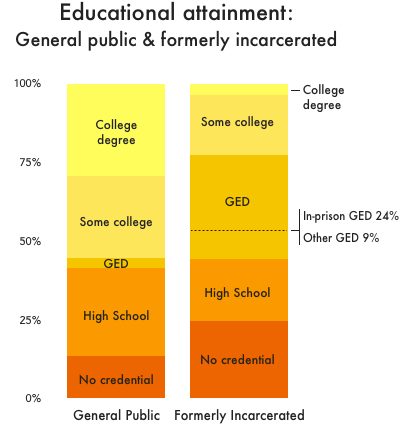

 Please welcome our new Policy Analyst, Alexi Jones.
Please welcome our new Policy Analyst, Alexi Jones.


